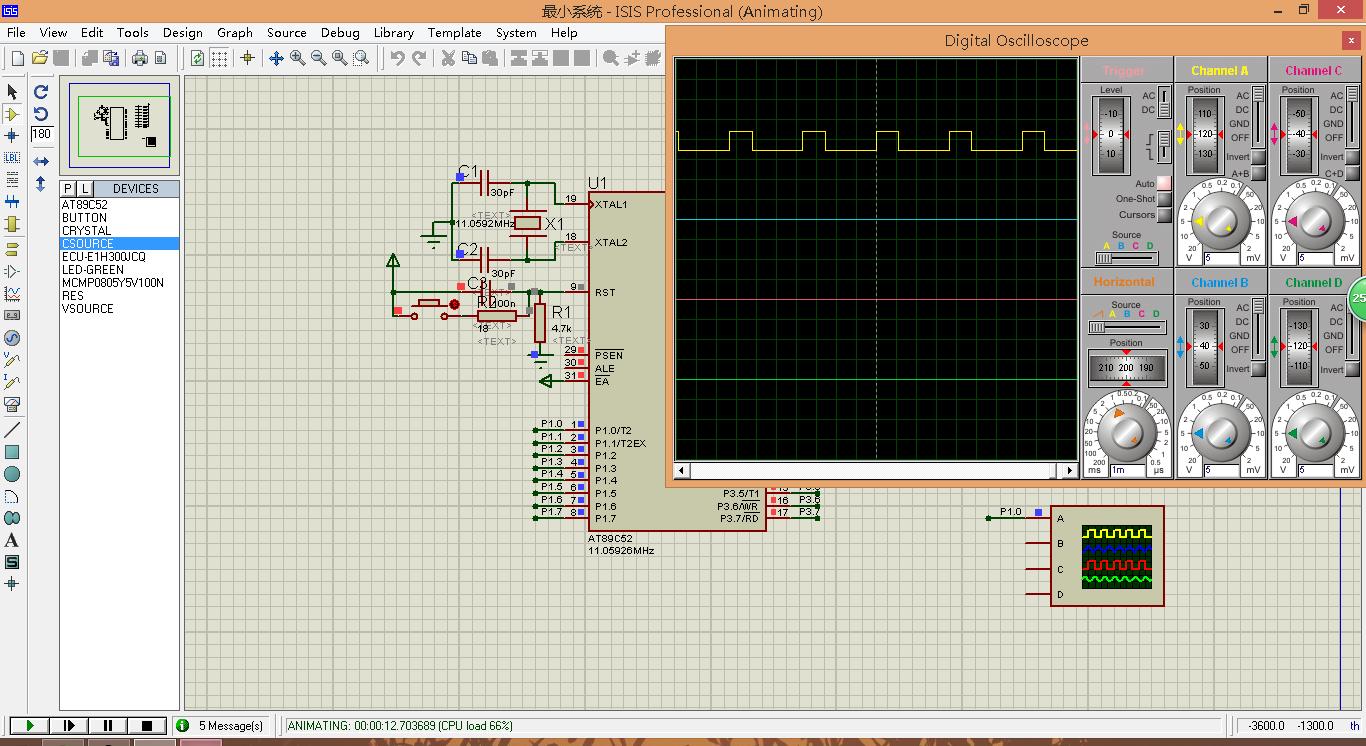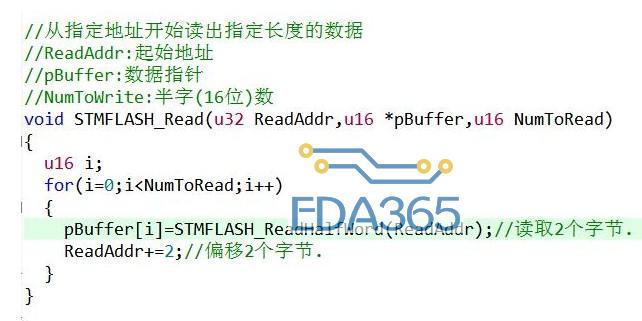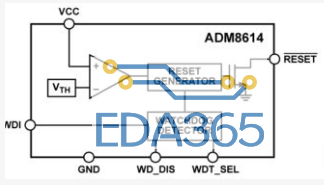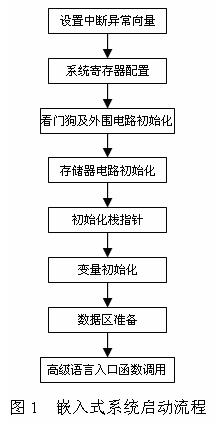stm32是自带硬件I2C,相比于软件模拟I2c,硬件I2c效率更高。但是据说不稳定,这个我倒暂时还没有体会到。
在最开始使用硬件I2c的时候,程序总是卡死,要不从一开始就卡死,要不从某一步开始卡死。我初学stm32,所以每学习一个模块都会把程序放进去,程序相互叠加。但是今天移植别人的硬件I2C却总是不能成功。一直是卡死在while等待;
while(!I2C_CheckEvent(I2C1, I2C_EVENT_MASTER_MODE_SELECT));
while(!I2C_CheckEvent(I2C1, I2C_EVENT_MASTER_TRANSMITTER_MODE_SELECTED));
while(!I2C_CheckEvent(I2C1, I2C_EVENT_MASTER_BYTE_TRANSMITTED));
while(I2C_GetFlagStatus(I2C1, I2C_FLAG_BUSY));
下面进行简单的分析:
1,很多时候,如果在线调试中发现从程序的第一个while就卡死,那很可能是配置有问题;比如SDA/SCL是否为开漏,I2C1时钟,GPIOB时钟是否开启,是否重复使用IO口导致异常,这里有个好方法就是把程序精简,就是把程序最简化,然后查错,纠正错误后再加;
2,可以用万用表看看你的IO口空闲时是不是上拉到高电平,我的程序就是用万用表测量SDA/SCL空闲不为高,这就有问题了,我查了很长时间没有引脚用重复,于是把多的程序全部删掉就好了。
3,这位楼主STM32 库I2c 调试成功!!!也是遇到功能用重复了,这里直接把帖子贴出来。
4,有位博主说他的硬件I2C 10K速率时稳定,但是我觉得不至于,我用200K读写都很正常,如果上诉不能解决,可以调整下速率看看效果。
之前写了一个写单字节的读写程序不能用,没办法我移植的是野火的《stm32库开发实战指南》的硬件I2C读写24C02的例程,下面贴上代码:(加上了少部分注释)
5, 经本人反复折腾发现,引脚在你认为的“空闲”时间表现为低电平的的另一种可能,就是程序写的有问题,AT24c0x把总线拉低表现为等待主机响应,要想知道是什么原因导致总线电平被拉低,可以重新插从器件供电,并使主器件复位(因为此时的主器件一般处于卡死循环状态),在不触发AT24c0x的情况下,测SDA,SCL的电平状态,查看是否为高电平,再触发读写从器件,结束后测SDA.SCL电平变化!
这个是头文件:
#ifndef __I2C_EE_H
#define __I2C_EE_H
#include
/* EEPROM Addresses defines */
#define EEPROM_Block0_ADDRESS 0xA0 /* E2 = 0 *///AT24C0x的I2C硬件地址
//#define EEPROM_Block1_ADDRESS 0xA2 /* E2 = 0 */
//#define EEPROM_Block2_ADDRESS 0xA4 /* E2 = 0 */
//#define EEPROM_Block3_ADDRESS 0xA6 /* E2 = 0 */
void I2C_EE_Init(void);
void I2C_EE_BufferWrite(u8* pBuffer, u8 WriteAddr, u16 NumByteToWrite);
void I2C_EE_ByteWrite(u8* pBuffer, u8 WriteAddr);
void I2C_EE_PageWrite(u8* pBuffer, u8 WriteAddr, u8 NumByteToWrite);
void I2C_EE_BufferRead(u8* pBuffer, u8 ReadAddr, u16 NumByteToRead);
void I2C_EE_WaitEepromStandbyState(void);
#endif /* __I2C_EE_H */
下面是C文件:
/********************************************************************************
* 文件名 :i2c_ee.c
* 描述 :i2c EEPROM(AT24C02)应用函数库
* 实验平台:野火STM32开发板
* 硬件连接:-----------------
* | |
* | PB6-I2C1_SCL |
* | PB7-I2C1_SDA |
* | |
* -----------------
* 库版本 :ST3.5.0
* 作者 :保留
* 论坛 :http://www.amobbs.com/forum-1008-1.html
* 淘宝 :http://firestm32.taobao.com
**********************************************************************************/
#include "i2c_ee.h"
#define I2C_Speed 200000
#define I2C1_OWN_ADDRESS7 0x0A //stm32z自身I2C地址,自己定义的
#define I2C_PageSize 8 /* AT24C02每页有8个字节 */
u16 EEPROM_ADDRESS;
/*
* 函数名:I2C_GPIO_Config
* 描述 :I2C1 I/O配置
* 输入 :无
* 输出 :无
* 调用 :内部调用
*/
static void I2C_GPIO_Config(void)
{
GPIO_InitTypeDef GPIO_InitStructure;
// 使能与 I2C1 有关的时钟 /
//RCC_APB2PeriphClockCmd(RCC_APB2Periph_GPIOB,ENABLE);
//RCC_APB1PeriphClockCmd(RCC_APB1Periph_I2C1,ENABLE);
// PB6-I2C1_SCL、PB7-I2C1_SDA/
GPIO_InitStructure.GPIO_Pin = GPIO_Pin_6 | GPIO_Pin_7;
GPIO_InitStructure.GPIO_Speed = GPIO_Speed_50MHz;
GPIO_InitStructure.GPIO_Mode = GPIO_Mode_AF_OD; // 开漏输出
GPIO_Init(GPIOB, &GPIO_InitStructure);
}
/*
* 函数名:I2C_Configuration
* 描述 :I2C 工作模式配置
* 输入 :无
* 输出 :无
* 调用 :内部调用
*/
static void I2C_Mode_Configu(void)
{
I2C_InitTypeDef I2C_InitStructure;
/* I2C 配置 */
I2C_InitStructure.I2C_Mode = I2C_Mode_I2C;
I2C_InitStructure.I2C_DutyCycle = I2C_DutyCycle_2;
I2C_InitStructure.I2C_OwnAddress1 =I2C1_OWN_ADDRESS7;
I2C_InitStructure.I2C_Ack = I2C_Ack_Enable ;
I2C_InitStructure.I2C_AcknowledgedAddress = I2C_AcknowledgedAddress_7bit;
I2C_InitStructure.I2C_ClockSpeed = I2C_Speed;
/* 使能 I2C1 */
I2C_Cmd(I2C1, ENABLE);
/* I2C1 初始化 */
I2C_Init(I2C1, &I2C_InitStructure);
}
/*
* 函数名:I2C_EE_Init
* 描述 :I2C 外设(EEPROM)初始化
* 输入 :无
* 输出 :无
* 调用 :外部调用
*/
void I2C_EE_Init(void)
{
I2C_GPIO_Config();
I2C_Mode_Configu();
/* 根据头文件i2c_ee.h中的定义来选择EEPROM要写入的地址 */
#ifdef EEPROM_Block0_ADDRESS
/* 选择 EEPROM Block0 来写入 */
EEPROM_ADDRESS = EEPROM_Block0_ADDRESS;
#endif
#ifdef EEPROM_Block1_ADDRESS
/* 选择 EEPROM Block1 来写入 */
EEPROM_ADDRESS = EEPROM_Block1_ADDRESS;
#endif
#ifdef EEPROM_Block2_ADDRESS
/* 选择 EEPROM Block2 来写入 */
EEPROM_ADDRESS = EEPROM_Block2_ADDRESS;
#endif
#ifdef EEPROM_Block3_ADDRESS
/* 选择 EEPROM Block3 来写入 */
EEPROM_ADDRESS = EEPROM_Block3_ADDRESS;
#endif
}
/*
* 函数名:I2C_EE_BufferWrite
* 描述 :将缓冲区中的数据写到I2C EEPROM中
* 输入 :-pBuffer 缓冲区指针
* -WriteAddr 接收数据的EEPROM的地址
* -NumByteToWrite 要写入EEPROM的字节数
* 输出 :无
* 返回 :无
* 调用 :外部调用
*/
void I2C_EE_BufferWrite(u8* pBuffer, u8 WriteAddr, u16 NumByteToWrite)
{
u8 NumOfPage = 0, NumOfSingle = 0, Addr = 0, count = 0;
Addr = WriteAddr % I2C_PageSize;//通过计算写入的初始地址是否从页的开始写
count = I2C_PageSize - Addr; //计算写的第一页需要写几个字节(写的首地址不在页的开始)
NumOfPage = NumByteToWrite / I2C_PageSize;//计算需要写几个整页
NumOfSingle = NumByteToWrite % I2C_PageSize;//计算写完整页后还剩几个字节没有写
/* If WriteAddr is I2C_PageSize aligned */
if(Addr == 0) //通写入的初始地址是从页的开始写
{
/* If NumByteToWrite
if(NumOfPage == 0) //如果写的小于一页,也就是只写NumOfSingle个数据
{
I2C_EE_PageWrite(pBuffer, WriteAddr, NumOfSingle);
I2C_EE_WaitEepromStandbyState();
}
/* If NumByteToWrite > I2C_PageSize */
else //如果写的大于等于一页,也就是写NumOfPage个整页
{
while(NumOfPage--)
{
I2C_EE_PageWrite(pBuffer, WriteAddr, I2C_PageSize);
I2C_EE_WaitEepromStandbyState();
WriteAddr += I2C_PageSize;
pBuffer += I2C_PageSize;
}
if(NumOfSingle!=0) //写完整页后剩下的不够一页的
{
I2C_EE_PageWrite(pBuffer, WriteAddr, NumOfSingle);
I2C_EE_WaitEepromStandbyState();
}
}
}
/* If WriteAddr is not I2C_PageSize aligned */
else //通写入的初始地址不是从页的开始写,这个要比前面的要复杂很多
{
/* If NumByteToWrite
if(NumOfPage== 0)
{
I2C_EE_PageWrite(pBuffer, WriteAddr, NumOfSingle);
I2C_EE_WaitEepromStandbyState();
}
/* If NumByteToWrite > I2C_PageSize */
else
{
NumByteToWrite -= count;
NumOfPage = NumByteToWrite / I2C_PageSize;
NumOfSingle = NumByteToWrite % I2C_PageSize;
if(count != 0) //先把第一页的几个数据写进去例如我写的首地址为5,则count=3,则从5写到7
{
I2C_EE_PageWrite(pBuffer, WriteAddr, count);
I2C_EE_WaitEepromStandbyState();
WriteAddr += count; //写地址加上count,前面没有对齐的数据写完,该写中间对齐的部分
pBuffer += count;
}
while(NumOfPage--)
{
I2C_EE_PageWrite(pBuffer, WriteAddr, I2C_PageSize);
I2C_EE_WaitEepromStandbyState();
WriteAddr += I2C_PageSize;
pBuffer += I2C_PageSize;
}
if(NumOfSingle != 0)//最后写最后几个没有对齐的数据,不够一整页
{
I2C_EE_PageWrite(pBuffer, WriteAddr, NumOfSingle);
I2C_EE_WaitEepromStandbyState();
}
}
}
}
/*
* 函数名:I2C_EE_ByteWrite
* 描述 :写一个字节到I2C EEPROM中
* 输入 :-pBuffer 缓冲区指针
* -WriteAddr 接收数据的EEPROM的地址
* 输出 :无
* 返回 :无
* 调用 :外部调用
*/
void I2C_EE_ByteWrite(u8* pBuffer, u8 WriteAddr)
{
/* Send STRAT condition */
I2C_GenerateSTART(I2C1, ENABLE);
/* Test on EV5 and clear it */
while(!I2C_CheckEvent(I2C1, I2C_EVENT_MASTER_MODE_SELECT));
/* Send EEPROM address for write */
I2C_Send7bitAddress(I2C1, EEPROM_ADDRESS, I2C_Direction_Transmitter);
/* Test on EV6 and clear it */
while(!I2C_CheckEvent(I2C1, I2C_EVENT_MASTER_TRANSMITTER_MODE_SELECTED));
/* Send the EEPROM's internal address to write to */
I2C_SendData(I2C1, WriteAddr);
/* Test on EV8 and clear it */
while(!I2C_CheckEvent(I2C1, I2C_EVENT_MASTER_BYTE_TRANSMITTED));
/* Send the byte to be written */
I2C_SendData(I2C1, *pBuffer);
/* Test on EV8 and clear it */
while(!I2C_CheckEvent(I2C1, I2C_EVENT_MASTER_BYTE_TRANSMITTED));
/* Send STOP condition */
I2C_GenerateSTOP(I2C1, ENABLE);
}
/*
* 函数名:I2C_EE_PageWrite
* 描述 :在EEPROM的一个写循环中可以写多个字节,但一次写入的字节数
* 不能超过EEPROM页的大小。AT24C02每页有8个字节。
* 输入 :-pBuffer 缓冲区指针
* -WriteAddr 接收数据的EEPROM的地址
* -NumByteToWrite 要写入EEPROM的字节数
* 输出 :无
* 返回 :无
* 调用 :外部调用
*/
void I2C_EE_PageWrite(u8* pBuffer, u8 WriteAddr, u8 NumByteToWrite)
{
while(I2C_GetFlagStatus(I2C1, I2C_FLAG_BUSY)); // Added by Najoua 27/08/2008
/* Send START condition */
I2C_GenerateSTART(I2C1, ENABLE);
/* Test on EV5 and clear it */
while(!I2C_CheckEvent(I2C1, I2C_EVENT_MASTER_MODE_SELECT));
/* Send EEPROM address for write */
I2C_Send7bitAddress(I2C1, EEPROM_ADDRESS, I2C_Direction_Transmitter);
/* Test on EV6 and clear it */
while(!I2C_CheckEvent(I2C1, I2C_EVENT_MASTER_TRANSMITTER_MODE_SELECTED));
/* Send the EEPROM's internal address to write to */
I2C_SendData(I2C1, WriteAddr);
/* Test on EV8 and clear it */
while(! I2C_CheckEvent(I2C1, I2C_EVENT_MASTER_BYTE_TRANSMITTED));
/* While there is data to be written */
while(NumByteToWrite--)
{
/* Send the current byte */
I2C_SendData(I2C1, *pBuffer);
/* Point to the next byte to be written */
pBuffer++;
/* Test on EV8 and clear it */
while (!I2C_CheckEvent(I2C1, I2C_EVENT_MASTER_BYTE_TRANSMITTED));
}
/* Send STOP condition */
I2C_GenerateSTOP(I2C1, ENABLE);
}
/*
* 函数名:I2C_EE_BufferRead
* 描述 :从EEPROM里面读取一块数据。
* 输入 :-pBuffer 存放从EEPROM读取的数据的缓冲区指针。
* -WriteAddr 接收数据的EEPROM的地址。
* -NumByteToWrite 要从EEPROM读取的字节数。
* 输出 :无
* 返回 :无
* 调用 :外部调用
*/
void I2C_EE_BufferRead(u8* pBuffer, u8 ReadAddr, u16 NumByteToRead)
{
//*((u8 *)0x4001080c) |=0x80;
while(I2C_GetFlagStatus(I2C1, I2C_FLAG_BUSY)); // Added by Najoua 27/08/2008
/* Send START condition */
I2C_GenerateSTART(I2C1, ENABLE);
//*((u8 *)0x4001080c) &=~0x80;
/* Test on EV5 and clear it */
while(!I2C_CheckEvent(I2C1, I2C_EVENT_MASTER_MODE_SELECT));
/* Send EEPROM address for write */
I2C_Send7bitAddress(I2C1, EEPROM_ADDRESS, I2C_Direction_Transmitter);
/* Test on EV6 and clear it */
while(!I2C_CheckEvent(I2C1, I2C_EVENT_MASTER_TRANSMITTER_MODE_SELECTED));
/* Clear EV6 by setting again the PE bit */
I2C_Cmd(I2C1, ENABLE);
/* Send the EEPROM's internal address to write to */
I2C_SendData(I2C1, ReadAddr);
/* Test on EV8 and clear it */
while(!I2C_CheckEvent(I2C1, I2C_EVENT_MASTER_BYTE_TRANSMITTED));
/* Send STRAT condition a second time */
I2C_GenerateSTART(I2C1, ENABLE);
/* Test on EV5 and clear it */
while(!I2C_CheckEvent(I2C1, I2C_EVENT_MASTER_MODE_SELECT));
/* Send EEPROM address for read */
I2C_Send7bitAddress(I2C1, EEPROM_ADDRESS, I2C_Direction_Receiver);
/* Test on EV6 and clear it */
while(!I2C_CheckEvent(I2C1, I2C_EVENT_MASTER_RECEIVER_MODE_SELECTED));
/* While there is data to be read */
while(NumByteToRead)
{
if(NumByteToRead == 1)
{
/* Disable Acknowledgement */
I2C_AcknowledgeConfig(I2C1, DISABLE);
/* Send STOP Condition */
I2C_GenerateSTOP(I2C1, ENABLE);
}
/* Test on EV7 and clear it */
if(I2C_CheckEvent(I2C1, I2C_EVENT_MASTER_BYTE_RECEIVED))
{
/* Read a byte from the EEPROM */
*pBuffer = I2C_ReceiveData(I2C1);
/* Point to the next location where the byte read will be saved */
pBuffer++;
/* Decrement the read bytes counter */
NumByteToRead--;
}
}
/* Enable Acknowledgement to be ready for another reception */
I2C_AcknowledgeConfig(I2C1, ENABLE);
}
/*
* 函数名:I2C_EE_WaitEepromStandbyState
* 描述 :Wait for EEPROM Standby state
* 输入 :无
* 输出 :无
* 返回 :无
* 调用 :
*/
void I2C_EE_WaitEepromStandbyState(void)
{
vu16 SR1_Tmp = 0;
do
{
/* Send START condition */
I2C_GenerateSTART(I2C1, ENABLE);
/* Read I2C1 SR1 register */
SR1_Tmp = I2C_ReadRegister(I2C1, I2C_Register_SR1);
/* Send EEPROM address for write */
I2C_Send7bitAddress(I2C1, EEPROM_ADDRESS, I2C_Direction_Transmitter);
}while(!(I2C_ReadRegister(I2C1, I2C_Register_SR1) & 0x0002));
/* Clear AF flag */
I2C_ClearFlag(I2C1, I2C_FLAG_AF);
/* STOP condition */
I2C_GenerateSTOP(I2C1, ENABLE);
}
/*************************END OF FILE*************************************/
『本文转载自网络,版权归原作者所有,如有侵权请联系删除』
 热门文章
更多
热门文章
更多









